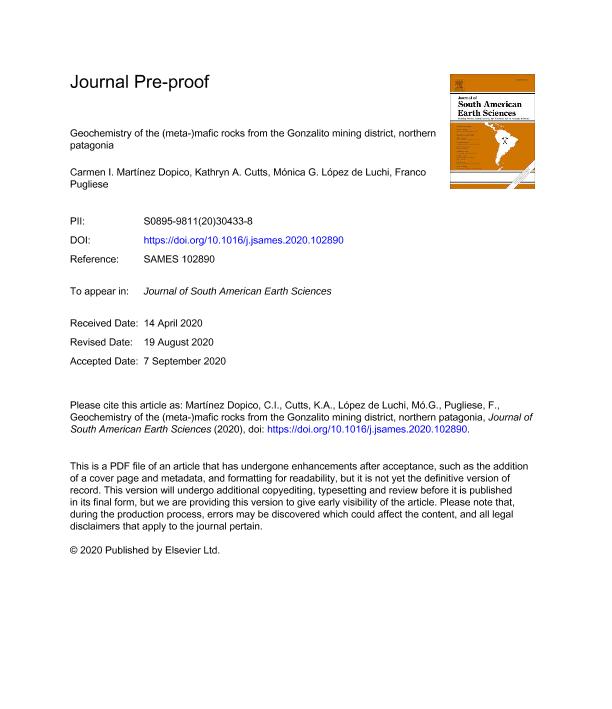Artículo
Geochemistry of the (meta-)mafic rocks from the Gonzalito mining district, northern Patagonia
Martínez Dopico, Carmen Irene ; Cutts, Kathryn Ann; Lopez, Monica Graciela
; Cutts, Kathryn Ann; Lopez, Monica Graciela ; Pugliese, Franco Eduardo
; Pugliese, Franco Eduardo
 ; Cutts, Kathryn Ann; Lopez, Monica Graciela
; Cutts, Kathryn Ann; Lopez, Monica Graciela ; Pugliese, Franco Eduardo
; Pugliese, Franco Eduardo
Fecha de publicación:
12/2020
Editorial:
Pergamon-Elsevier Science Ltd
Revista:
Journal of South American Earth Sciences
ISSN:
0895-9811
Idioma:
Inglés
Tipo de recurso:
Artículo publicado
Clasificación temática:
Resumen
In spite of hosting one of the most important Pb–Ag–Zn mineralizations in Patagonia, the metamorphic history of the rocks of the Mina Gonzalito Complex (MGC; east of the North Patagonian Massif) is still unclear. The complex consists of schists, para- and ortho-derived gneisses, ranging from greenschist to amphibolite facies, and metamafic rocks. Leucogranites and pegmatites were intruded synkinematically. Field, petrological and thermochronological evidence indicates that the MGC experienced an early prograde path and metamorphic peak during the Early Ordovician (ca. 472 Ma), magmatism and localized post-peak deformation and re-equilibrium at lower pressure, followed by uplift during the Late Permian. The MGC is intruded by the calc-alkaline Santa Rosa Diorite (SiO2 = 58.7–60.4 wt%; LaN/YbN = 7.2–10.5) and trachyte dike swarms in the Late Permian- Early Triassic. The mafic intrusives of the MGC form small schistose, massive and banded bodies interlayered within the gneisses and granites and recorded recrystallization of hornblende + plagioclase + quartz + titanite ± clinopyroxene ± biotite ± ilmenite. The metamafic rocks are mostly tholeiitic gabbros having SiO2 (45.4–52.1 wt%), TiO2 (0.62–2.88 wt%), flat REE patterns (LaN/YbN = 0.48–2.76), although some pyroxene-banded varieties show higher ratios. Initial P–T modelling in the NCKFMASHTO system for the metamafic rocks defined P-T conditions between 550 and 730 °C and 1–4 kbar. Our data suggest that the protolith of the metamafic rocks was emplaced in a shallow environment, associated with underplating of mantle-derived magmas slightly modified by crustal contamination. The intrusion of mantle-derived magmas may have been related either to a magmatic arc or to a continental rift environment. The model involving an Ordovician intracontinental back-arc basin is favored herein because it can reasonably explain many other geological features of Early Paleozoic basement rocks from northern Patagonia.
Palabras clave:
GABBROS
,
GONDWANA
,
NORTH PATAGONIAN MASSIF
,
ORDOVICIAN
Archivos asociados
Licencia
Identificadores
Colecciones
Articulos(CICTERRA)
Articulos de CENTRO DE INVEST.EN CS.DE LA TIERRA
Articulos de CENTRO DE INVEST.EN CS.DE LA TIERRA
Articulos(INGEIS)
Articulos de INST.DE GEOCRONOLOGIA Y GEOLOGIA ISOTOPICA (I)
Articulos de INST.DE GEOCRONOLOGIA Y GEOLOGIA ISOTOPICA (I)
Citación
Martínez Dopico, Carmen Irene; Cutts, Kathryn Ann; Lopez, Monica Graciela; Pugliese, Franco Eduardo; Geochemistry of the (meta-)mafic rocks from the Gonzalito mining district, northern Patagonia; Pergamon-Elsevier Science Ltd; Journal of South American Earth Sciences; 104; 12-2020; 1-49
Compartir
Altmétricas



